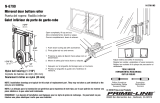
11
Maintaining Tools
Keep your tool in good repair by adopting a
regular maintenance program. Before use,
examine the general condition of your tool.
Inspect guards, switches, tool cord set and
extension cord for damage. Check for
loose screws, misalignment, binding of
moving parts, improper mounting, broken
parts and any other condition that may af-
fect its safe operation. If abnormal noise
or vibration occurs, turn the tool off imme-
diately and have the problem corrected
before further use. Do not use a damaged
tool. Tag damaged tools “DO NOT USE” until
repaired (see “Repairs”).
Under normal conditions, relubrication is
not necessary until the motor brushes
need to be replaced. After six months to
one year, depending on use, return your
tool to the nearest
MILWAUKEE
service
facility for the following:
• Lubrication
• Brush inspection and replacement
• Mechanical inspection and cleaning
(gears, spindles, bearings, housing,
etc.)
• Electrical inspection (switch, cord,
armature, etc.)
• Testing to assure proper mechanical
and electrical operation
Cleaning
Clean dust and debris from vents. Keep
the tool handles clean, dry and free of oil
or grease. Use only mild soap and a damp
cloth to clean your tool since certain clean-
ing agents and solvents are harmful to plas-
tics and other insulated parts. Some of
these include: gasoline, turpentine, lacquer
thinner, paint thinner, chlorinated cleaning
solvents, ammonia and household deter-
gents containing ammonia. Never use flam-
mable or combustible solvents around tools.
WARNING!
To reduce the risk of injury, al-
ways unplug your tool before
performing any maintenance.
Never disassemble the tool or try
to do any rewiring on the tool's
electrical system. Contact a
MILWAUKEE
service facility for
ALL repairs.
MAINTENANCE
1. Insert screw into the insert bit and align
the bit against the work surface.
2. Pull the trigger while pushing the tool
forward. This motion will engage the
snap-action clutch, causethe screw to
start rotating, sink the screw and dis-
engage the snap-action clutch within a
fraction of a second. If pressure is not
maintained on the tool after engaging
the snap-action clutch, the screw will
not properly seat.
The snap-action clutch will automati-
cally disengage and the insert bit will
stop rotating once the screw has been
driven to the selected depth.
These screwdrivers feature a snap-
action clutch, which may ratchet slightly
when the screw is sunk to the selected
depth.
NOTE: Practice driving screws into
pieces of scrap material to become
familiar with the tool and the snap-
action clutch action before attempting
to drive screws into the workpiece.
3. To remove screws, remove the locator
assembly and switch the forward/
reverse switch to the reverse position.
Reattaching the locator assembly will
not change the depth setting.
Driving Wood Screws
When driving wood screws, a pilot hole is
recommended to make driving easier and
to prevent splitting the wood. As a general
rule, the pilot hole should have a diameter
of approximately 70% the size of the
screw diameter. Hardwood pilot holes
should have a diameter of approximately
90% the size of the screw diameter. The
depth of the pilot hole should be shorter
than the length of the screw by at least
one screw diameter. This allows the tip of
the screw to bite into the wood for extra
holding power.
Counterbore the top portion of the hole for
a free fit of the shank between the screw
head and the threads. When using flat head
screws, countersink the top of the hole to
allow the screw head to be driven flush
with the work surface. Use soap or wax
for easier screw insertion if necessary.














